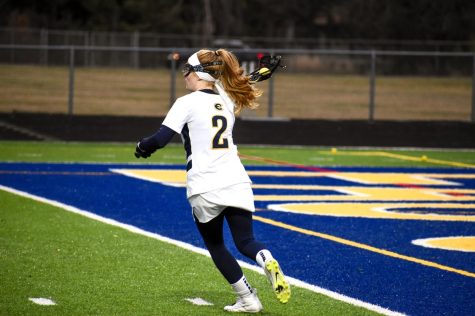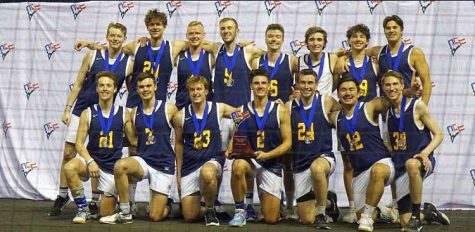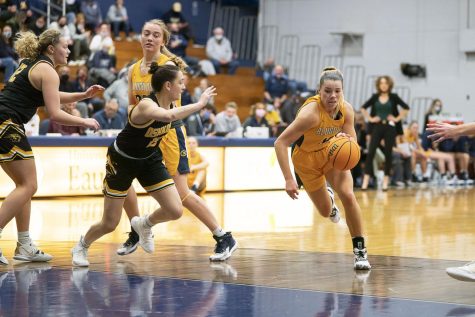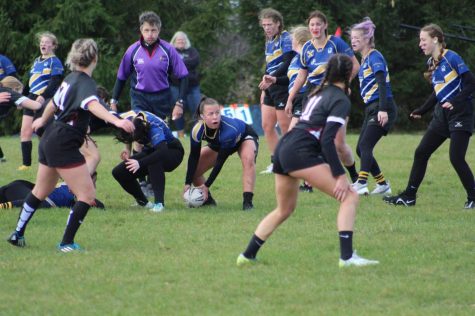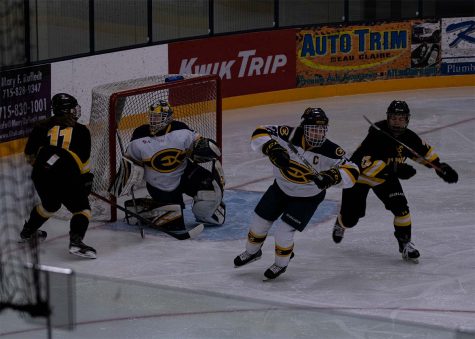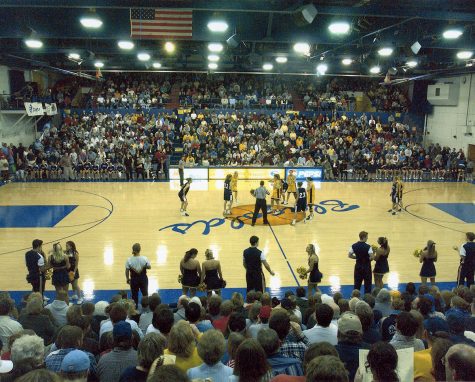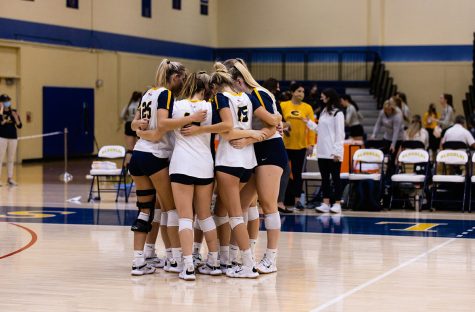Mind over altitude
UW-Eau Claire senior feeds high elevation hunger as Environmental Adventure Center climbing guide
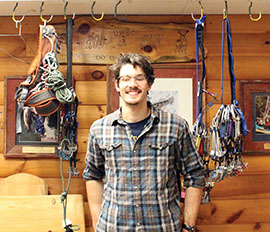
Mark Green was resting after a climb at Vertical Endeavors, an indoor rock climbing gym in Minneapolis, when he saw his friend miss a hold high up.
Green’s friend had scrambled up the face of a sunken pit, and was upside down on the ceiling when he missed a peg. He shattered his wrist on a guard rail as he fell, though his parter tried to catch him.
“Its amazing that’s the only thing that happened to him, it could have been way worse,” Green said.
But it took his friend more than two years to regain full motion in his wrist.
Green, a UW-Eau Claire senior, knows risks come with steep territory. He’s been working at the Environmental Adventure Center for the last three years, guiding climbing trips and working at the campus rock wall.
Eau Claire senior business management major and fellow EAC staff member Sam Worple was “forced” to climb with Green on a staff-only trip to Devil’s Lake
this summer.
“Mark’s a great guy,” Worple said. “He really knows his stuff when it comes to climbing.”
Worple said he’s glad his bosses made him strap into a harness during the trip. Climbing is just one more thing he’ll do on future adventures, he said.
Green started climbing his senior year of high school at Vertical Endeavors. It didn’t take him long to trade high school hobbies theater and track for foothold hunting.
Green said he remembers going on family climbing trips in California before moving to the Twin Cities. Green’s father, a former climber himself, lent some of his old climbing gear to get his son started.
On a trip to The Peacemaker in Tuscon, Ariz. he had to confront challenges of open nature climbing.
Climbers use metal hinges drilled into rock to loop supporting ropes through. The Peacemaker is a seven-pitch ascent, or 1,000 feet top to bottom.
It takes two ropes to conquer the 1,000-foot climb — one for the ascent and another on the way down. But Green said they were so excited to get on the mountain they forgot one of the ropes in the car.
The pair didn’t realize they were short one rope until they were perched on top of the peak.
Green and his friend had no other choice but to repel down the rock, putting all their weight on bolts screwed into the side of the face.
“This is just putting our faith into this piece of metal that was drilled into the rock,” Green said. “Hopefully whoever put it there did a good job, because we’d be pretty screwed.”
Risk
Although gym climbing is usually safer than climbing outdoors, Green said injuries do happen.
Green turned over his right hand and laid it palm up on a woodgrain table in the EAC. His fingertips are dotted with purple blood blisters. The pads of his fingers are a road-map of callouses.
Green was climbing on an indoor wall a year and a half ago when he heard a pop in his right hand. He’d heard other climbers talk about the sound.
It was the annular ligaments, or pulleys, in his fingers snapping. Green said he should have repelled down the wall and stuck his hand in a bag of ice to keep the injury at bay.
But he didn’t.
“What you’ll hear is pop, pop, and then your fingers don’t work as well,” he said. “It sucks, and it’s been a long road. I’ve had to start from ground zero.”
Green kept pushing up the wall. He said it was one of his best climbs, but it cost him a year and a half of challenging pitches.
Green said he had to keep himself away from climbing to allow his hand to heal, although he knew he could have kept climbing hard ascents when he was injured.
He just started last summer to ease himself back into the advanced climbs he was comfortable with two years ago.
Reward
On his trip to Tuscon, Green and his friend paused on top of The Pacemaker. They couldn’t stay long. They needed to touch the ground before the sun touched the horizon.
“You get to the top, and it’s just so fleeting,” Green said. “It’s a very short moment compared to the rest of the climb. It really humbles you a lot because when you’re above it all it sort of makes you realize you’re pretty small in the grand scale.”
People mistake climbing for a solo sport, Green said. Climbing teaches you how to rely on other people, the people who placed the holds before you, and your partner.
“Our moments in life and in the universe are so fleeting.” Green said. “And yet they’re infinite as well, because we perceive them to be so.”
Release
Rebekah Morrisson, an Eau Claire senior, grew up rock climbing indoors and outdoors in California.
“My mom always said I could climb before I could walk,” Morrisson said.
She transferred to Eau Claire from a California community college after seeing a poster of a Wisconsin forest in one of her classrooms.
And after moving to Wisconsin, she’s seen plenty of forest on EAC trips like one she took to Devil’s Lake three weeks ago.
While Morrisson said she doesn’t climb as much as she did as a kid, Green and other EAC guides were there to help her find footholds.
“Mark was the one who made sure we had all the food and gear packed,” she said. “He really knows Devil’s Lake and could find the runs… he makes sure we all have a good time.”
Although Green will graduate in the spring with a degree in hydrogeology, he’s not interested in finding a desk job right out of school.
He plans to move out west and put the climbing certifications he’s been crossing off for the past two years to good use.
“I love teaching people how to climb,” Green said. “I want to be a guide because I like pushing people a little bit, I like changing people’s worldview and open their mind.”
And most legendary climbers aren’t hydrogeologists. They’re dirtbags.
In the climbing community, dropping off the grid, living in a van and pursuing the next big climb means more than checking off a list of technical or high altitude summits, Green said. It’s called dirtbagging, or chasing the next
epic moment.
“I hold a huge amount of respect for people who are dirtbagging it,” Green said. “And hopefully I’ll be doing that at some point. I’d like to hit the road. It would be a cool way to live.”

